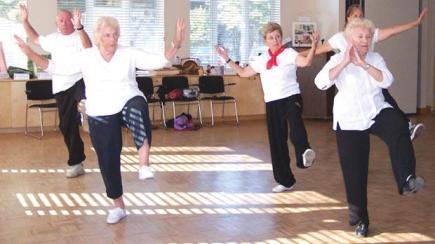This week I had a big girl job interview and as part of it I had to present a ten minute speech about increasing exercise participation in a target population. I researched it quite a lot and there was a large amount I couldn’t actually fit into the time frame so I decided to write it up into a post. Enjoy!
There is a general trend that as our age increases our exercise levels decrease. There are many reasons for this; time constraints, money constraints, or general tiredness from our busy lives. However 3/4s of the older adult population are not exercising to recommended levels. Evans (1999) went so far as to say that there is no segment of the population that can benefit more from exercise than the elderly.
Exercise is of course wonderful for our health – even if it doesn’t feel like it at the time. For the elderly population, exercise can reduce the risk of diabetes, lower blood pressure, reduce risks of osteoarthritis and osteoporosis, and help with weight management. Exercise programmes that focus on improving balance and strength can decrease the number of falls and reduce physical frailty, so any falls are less risk. In depressed elderly adults, meeting for group exercise can provide social support and reduce depression symptoms.
If exercise is so great then why aren’t they doing it? It could be a generational thing – my generation has a greater exposure to gyms, races, activities, even healthy food, yet for the older generation this is relatively new; they’ve never had cross-fit, wolf runs, or tough mudders. Gyms can be a scary place – there’s a lot of equipment that they don’t know how to work. Bodies suffer wear and tear so this generation has a fear of injury – particularly re-injury of joint replacements. Another factor is that many of this generation must rely on public transport to get around so that can take a lot of effort and may not be on a route to a sports centre.
What exercises can this group do?
Any casual exercise programme should be straightforward and fun – aerobics and dancercise classes fit that bill. The music can be adjusted to songs from their “heyday” such as Chuck Berry, Elvis Presley, old school fifties Rock and Roll. It can also be adapted to different abilities: for people who find it easy, small hand weights can be provided of a few kilograms which emulates lifting shopping and laundry; for people who struggle with balance then exercises can be performed whilst sitting down like swinging legs and tapping feet; aerobics can also be performed in the water which relieves the impact on joints and reduces risk of injury.  Another great, but under performed, activity is Tai Chi. It’s a martial art but not a typical combat one. It involves balance and shifting weight between the legs which makes it excellent for elderly people because the focus is on improving balance. It is also a low demand activity involving slow, flowing movements – perfect for people who currently do not exercise, or are unable to exert themselves too much. It can be adapted for people in wheelchairs, and can settle people who are perhaps restless in retirement. Tai Chi can also reduce the number of falls in this population too.
Another great, but under performed, activity is Tai Chi. It’s a martial art but not a typical combat one. It involves balance and shifting weight between the legs which makes it excellent for elderly people because the focus is on improving balance. It is also a low demand activity involving slow, flowing movements – perfect for people who currently do not exercise, or are unable to exert themselves too much. It can be adapted for people in wheelchairs, and can settle people who are perhaps restless in retirement. Tai Chi can also reduce the number of falls in this population too.
Sooooo, anyone for Tai Chi?
